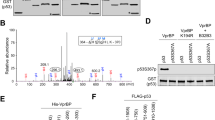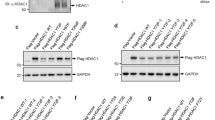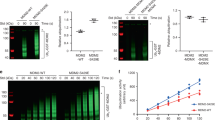Abstract
p53 stability is regulated by HDM2, a RING domain protein that acts as an E3 ligase to ubiquitinate p53 and target its degradation. Phosphorylation of HDM2 on serine 166 by AKT has been shown to enhance HDM2 activity and promote the degradation of p53. Here, we show that MAPKAP kinase 2 (MK2) can phosphorylate HDM2 on serine 157 and 166 in vitro. Treatment of cells with anisomycin, which activates MK2, also results in phosphorylation of HDM2 on serine 157 and 166 in vivo. Mutation of the MK2 phosphorylation sites in HDM2 to aspartic acid renders HDM2 slightly more active in the degradation of p53, and mouse cells deficient for MK2 show reduced Mdm2 phosphorylation and elevated levels of p53 protein. Together, our results suggest that MK2 may act to dampen the extent and duration of the p53 response.
This is a preview of subscription content, access via your institution
Access options
Subscribe to this journal
Receive 50 print issues and online access
$259.00 per year
only $5.18 per issue
Buy this article
- Purchase on Springer Link
- Instant access to full article PDF
Prices may be subject to local taxes which are calculated during checkout





Similar content being viewed by others
References
Ashcroft M, Woods DB, Copeland TD and Vousden KH . (2002). Oncogene, 21, 1955–1962.
Bates S, Hickman ES and Vousden KH . (1999). Mol. Carcinogen., 24, 7–14.
Blattner C, Hay T, Meek DW and Lane DP . (2002). Mol. Cell. Biol., 22, 6170–6182.
Boyd SD, Tsai KY and Jacks T . (2000). Nat. Cell Biol., 2, 563–568.
Brignone C, Bradley KE, Kisselev AF and Grossman SR . (2004). Oncogene, 23, 4121–4129.
Bulavin D, Saito S, Hollander MC, Sakaguchi K, Anderson CW, Appella E and Fornace Jr AJ . (1999). EMBO J., 18, 6845–6854.
Burch LR, Scott M, Pohler E, Meek D and Hupp T . (2004). J. Mol. Biol., 337, 115–128.
Dornan D, Wertz I, Shimizu H, Arnott D, Frantz GD, Dowd P, O'Rourke K, Koeppen H and Dixit VM . (2004). Nature, 429, 86–92.
Fang S, Jensen JP, Ludwig RL, Vousden KH and Weissman AM . (2000). J. Biol. Chem., 275, 8945–8951.
Feng J, Tamaskovic R, Yang Z, Brazil DP, Merlo A, Hess D and Hemmings BA . (2004). J. Biol. Chem., 279, 35510–35517.
Geyer RK, Yu ZK and Maki CG . (2000). Nat. Cell Biol., 2, 569–573.
Glockzin S, Ogi F-X, Hengstermann A, Scheffner M and Blattner C . (2004). Mol. Cell. Biol., 23, 8960–8969.
Gu J, Nie N, Wiederschain D and Yuan Z-M . (2001). Mol. Cell. Biol., 21, 8533–8546.
Haupt Y, Maya R, Kazaz A and Oren M . (1997). Nature, 387, 296–299.
Hazzalin CA, Cano E, Cuenda A, Barratt MJ, Cohen P and Mahadevan LC . (1996). Curr. Biol., 6, 1028–1031.
Hazzalin CA, Le Panse R, Cano E and Mahadevan LC . (1998). Mol. Cell. Biol., 18, 1844–1854.
Honda R, Tanaka H and Yasuda H . (1997). FEBS Lett., 420, 25–27.
Jones SN, Roe AE, Donehower LA and Bradley A . (1995). Nature, 378, 206–208.
Kotlyarov A, Neininger A, Schubert C, Eckert R, Birchmeier C, Volk HD and Gaestel M . (1999). Nat. Cell Biol., 1, 94–97.
Kubbutat MHG, Jones SN and Vousden KH . (1997). Nature, 387, 299–303.
Kubbutat MHG and Vousden KH . (1998). Mol. Med. Today, 4, 250–256.
Lai Z, Ferry KV, Diamond MA, Wee KE, Kim YB, Ma J, Yamg T, Benfield PA, Copland RA and Auger KR . (2001). J. Biol. Chem., 276, 31357–31367.
Lawlor MA and Alessi DR . (2001). J. Cell. Sci., 114, 2903–2910.
Leng RP, Lin Y, Ma W, Wu H, Lemmers B, Chung S, Parant JM, Lozano G, Hakem R and Benchimol S . (2003). Cell, 112, 779–791.
Li M, Brooks CL, Wu-Baer F, Chen D, Baer R and Gu W . (2003). Science, 302, 1972–1975.
Linke SP, Clarkin KC, Di Leonardo A, Tsou A and Wahl GM . (1996). Genes Dev., 10, 934–947.
Lohrum MA, Ludwig RL, Kubbutat MHG, Hanlon M and Vousden KH . (2003). Cancer Cell, 3, 577–587.
Lohrum MAE, Woods DB, Ludwig RL, Bálint E and Vousden KH . (2001). Mol. Cell. Biol., 21, 8521–8532.
Mayo L and Donner DB . (2001). Proc. Natl. Acad Sci. USA, 98, 11598–11603.
Meek DW and Knippschild U . (2003). Mol. Cancer Res., 1, 1017–1026.
Mendrysa SM, McElwee MK, Michalowski J, O'Leary KA, Young KM and Perry ME . (2003). Mol. Cell. Biol., 23, 462–472.
Michael D and Oren M . (2002). Curr. Opin. Genet. Dev., 12, 53–59.
Montes de Oca Luna R, Wagner DS and Lozano G . (1995). Nature, 378, 203–206.
Morrison DK, Heidecker G, Rapp UR and Copeland TD . (1993). J. Biol. Chem., 268, 17309–17316.
Nakamura S, Roth JA and Muckopadhay T . (2000). Mol. Cell. Biol., 20, 9391–9398.
Olson JM and Hallahan AR . (2004). Trends Mol. Med., 10, 125–129.
Perry ME . (2004). Mol. Cancer Res., 2, 9–19.
Rodriguez M, Desterro JMP, Lain S, Lane DP and Hay RT . (2000). Mol. Cell. Biol., 20, 8458–8467.
Rowan S, Ludwig RL, Haupt Y, Bates S, Lu X, Oren M and Vousden KH . (1996). EMBO J., 15, 827–838.
She QB, Chen N and Dong Z . (2000). J. Biol. Chem., 275, 20444–20449.
She QB, Ma WY and Dong Z . (2002). Oncogene, 21, 1580–1589.
Sherr CJ . (1998). Genes Dev., 12, 2984–2991.
Stommel JM and Wahl GM . (2004). EMBO J., 23, 1547–1556.
Tibbles LA and Woodgett JR . (1999). Cell Mol. Life Sci., 15, 1230–1254.
Vousden KH . (2000). Cell, 101, 691–694.
Wu GS . (2004). Cancer Biol. Ther., 3, 156–161.
Xu Y . (2003). Cell Death Differ, 10, 400–403.
Zhang Y, Wolf GW, Bhat K, Jin A, Allio T, Burkhart WA and Xiong Y . (2003). Mol. Cell. Biol., 23, 8902–8912.
Zhou BP, Liao W, Zou Y, Spohn B and Hung M-C . (2001). Nat. Cell Biol., 3, 973–982.
Acknowledgements
We are extremely grateful to Brian Hemmings for the mouse anti-Mdm2-P-ser166 antibody. This work was funded by Cancer Research UK, the National Cancer Institute and the Deutsche Forschungsgemeinschaft.
Author information
Authors and Affiliations
Corresponding author
Rights and permissions
About this article
Cite this article
Weber, H., Ludwig, R., Morrison, D. et al. HDM2 phosphorylation by MAPKAP kinase 2. Oncogene 24, 1965–1972 (2005). https://doi.org/10.1038/sj.onc.1208389
Received:
Revised:
Accepted:
Published:
Issue Date:
DOI: https://doi.org/10.1038/sj.onc.1208389
Keywords
This article is cited by
-
Signaling of MK2 sustains robust AP1 activity for triple negative breast cancer tumorigenesis through direct phosphorylation of JAB1
npj Breast Cancer (2021)
-
MAPKAPK2: the master regulator of RNA-binding proteins modulates transcript stability and tumor progression
Journal of Experimental & Clinical Cancer Research (2019)
-
Role of the PDZ-scaffold protein NHERF1/EBP50 in cancer biology: from signaling regulation to clinical relevance
Oncogene (2017)
-
Pim kinases in hematological malignancies: where are we now and where are we going?
Journal of Hematology & Oncology (2014)
-
IKK-β mediates hydrogen peroxide induced cell death through p85 S6K1
Cell Death & Differentiation (2013)



